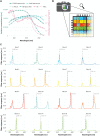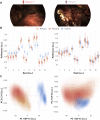Spectral imaging enables contrast agent-free real-time ischemia monitoring in laparoscopic surgery
- PMID: 36897951
- PMCID: PMC10005169
- DOI: 10.1126/sciadv.add6778
Spectral imaging enables contrast agent-free real-time ischemia monitoring in laparoscopic surgery
Abstract
Laparoscopic surgery has evolved as a key technique for cancer diagnosis and therapy. While characterization of the tissue perfusion is crucial in various procedures, such as partial nephrectomy, doing so by means of visual inspection remains highly challenging. We developed a laparoscopic real-time multispectral imaging system featuring a compact and lightweight multispectral camera and the possibility to complement the conventional surgical view of the patient with functional information at a video rate of 25 Hz. To enable contrast agent-free ischemia monitoring during laparoscopic partial nephrectomy, we phrase the problem of ischemia detection as an out-of-distribution detection problem that does not rely on data from any other patient and uses an ensemble of invertible neural networks at its core. An in-human trial demonstrates the feasibility of our approach and highlights the potential of spectral imaging combined with advanced deep learning-based analysis tools for fast, efficient, reliable, and safe functional laparoscopic imaging.
Figures








References
-
- Thompson R. H., Frank I., Lohse C. M., Saad I. R., Fergany A., Zincke H., Leibovich B. C., Blute M. L., Novick A. C., The impact of ischemia time during open nephron sparing surgery on solitary kidneys: A multi-institutional study. J. Urol. 177, 471–476 (2007). - PubMed
-
- Borofsky M. S., Gill I. S., Hemal A. K., Marien T. P., Jayaratna I., Krane L. S., Stifelman M. D., Near-infrared fluorescence imaging to facilitate super-selective arterial clamping during zero-ischaemia robotic partial nephrectomy. BJU Int. 111, 604–610 (2013). - PubMed
-
- Tobis S., Knopf J. K., Silvers C. R., Marshall J., Cardin A., Wood R. W., Reeder J. E., Erturk E., Madeb R., Yao J., Singer E. A., Rashid H., Wu G., Messing E., Golijanin D., Near infrared fluorescence imaging after intravenous indocyanine green: Initial clinical experience with open partial nephrectomy for renal cortical tumors. Urology 79, 958–964 (2012). - PubMed
-
- Gandaglia G., Schatteman P., De Naeyer G., D’Hondt F., Mottrie A., Novel technologies in urologic surgery: A rapidly changing scenario. Curr. Urol. Rep. 17, 19 (2016). - PubMed
MeSH terms
Substances
LinkOut - more resources
Full Text Sources

